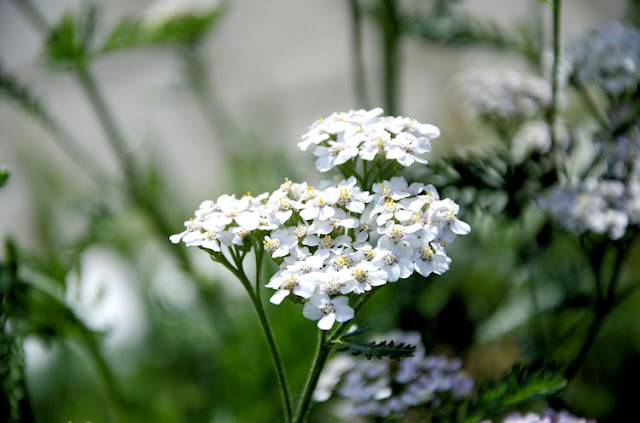 |
| Article © Debs Cook Image by Tatiana6 |
Whereas many herbs have a clear focus of use – such as thyme for coughs or chamomile for stomach problems, this therapeutic clarity is lacking for Yarrow and so its potential healing properties are often overlooked in favour of other herbs, even by herbal practitioners. Hence, Yarrow ends up only being used in teas for the management of viral-induced fevers. Although this is a wonderful feature of yarrow, it is by no means its only attributes and the broad range of its current and historical applications reflects the unusually high number of physiologically active compounds it contains. In the first part of this 2-part article on Yarrow, the modern view of the herb is explored. Part 2 gives an overview of its traditional use from various documented sources. In interpreting the ancient texts, a major stumbling block to our understanding is that disease conditions were named much less specifically than today, as some of these quotes below show.
Common Yarrow is a perennial herb that often gets listed as a weed, wildflower or a perennial garden flower depending on which publication you are reading. It can be found in meadows, at the side of roads, in lawns and grassland and will self-seed readily if allowed to in the garden.
The Latin name, Achillea millefolium, is derived from the fact that the herb was dedicated to the God Achilles by the Greeks and the millefolium refers to the many fine leaflets on each yarrow leaf. The Greeks dedicated the herb yarrow to the Achilles, whom they believed cured warriors using yarrow leaves during the battle at Troy. This is probably why yarrow received the name Soldier's Woundwort, they also used it to stop haemorrhaging. Dioscorides in the 1st century A.D. considered it to be “excellent for an excessive discharge of blood, old and new ulcers, and for fistulas [ulcers].”
An underrated herb with a myriad uses, Yarrow has been in documented use as a cold remedy since the Middle Ages. The 12th century German herbalist and Abbess, Hildegard Von Bingen, recommended taking wine infused with powdered yarrow to help heal wounds and to manage fevers. The Druids made amulets from yarrow to protect them from evil. And it was also believed to attract friends and distant relations to you when you’d lost touch. If added to a bridal bouquet, it was also believed to ensure that love will last for at least seven years.
By the 16th century herbalist John Gerard knew yarrow also as Nose-Bleed and cited its uses as being a remedy for toothache, diarrhoea, migraine and as a means of curing excessive ejaculation, writing that yarrow ”cureth the inward excorations of the yard of a man, coming by reason of pollutions of extreme flowing of the seed, although” he cautioned “the issue does cause inflammation and swelling of those secret parts, though the spermaticke matter do come downe in great quantity, if the juice be injected with a syringe , or the decoction.”
Culpeper in the 17th century recommended yarrow for its astringent nature, for treating piles, writing “As a medicine [yarrow] is drying and binding. A decoction of it boiled with white wine, is good to stop the running of the reins in men, and whites in women; restrains violent bleedings, and is excellent for the piles. A strong tea in this case should be made of the leaves, and drank plentifully; and equal parts of it, and of toad flax, should be made into a poultice with pomatum, and applied outwardly. This induces sleep, eases the pain, and lessens the bleeding. An ointment of the leaves cures wounds, and is good for inflammations, ulcers, fistulas, and all such runnings as abound with moisture.”
Sir John Hill in his 18th century ‘Family Herbal’ echoed Culpeper’s use for yarrow as a treatment for piles adding his own remedy of a sweetened decoction, he recommended that the tops of the herb (flowers and young leaves) were best used fresh writing that “these are to be boiled in water, and the decoction sweetened with fine sugar”, the resulting liquid he wrote was “excellent against the bleeding of the piles, and bloody fluxes, and overflowing of the menses”.
In his 19th century ‘Model Botanic Guide to Health’ William Fox M.D. wrote of yarrow “There is not a single herb in the whole vocabulary that has done so much good, or is more universally esteemed; it has prevented more disease and doctor’s bills than all the books they have written about medical science.” Glowing praise indeed, Fox used yarrow in many of the same ways that his herbal predecessors did, writing that “a strong infusion is a specific to stay haemorrhage in the bowels,” and that “lint steeped in [an infusion of yarrow] and put up the nostrils will stop bleeding of the nose.”
Yarrow continues to be a versatile herb being particularly valued for managing fevers, but clearly having broader applications according to these texts. This useful and aromatic herb grows prolifically near to me providing a good supply in late summer to make tinctures, to dry ready for yarrow tea or to make a wonderful herbal inhalant.
Disclaimer: Whilst every effort has been made to source the most up to date and accurate information, we cannot guarantee that remedies in our articles are effective, when in doubt, consult your GP or a qualified Medicinal Herbalist. Remember also that herbal remedies can be dangerous under certain circumstances therefore you should always seek medical advice before self-treating with a homemade remedy, especially if you are pregnant, breast feeding or suffer from any known illness which could be adversely affected by self-treatment.
